Reasons for Choosing Ubuntu Operating System
VerifiedAdded on 2023/06/10
|21
|2336
|197
AI Summary
This article discusses the reasons why Ubuntu Operating System is a great choice for your computer. It covers its easy setup, cost-effectiveness, and security features. It also provides a step-by-step guide on how to set up Ubuntu Server on Virtual Box, configure network shares, and implement data redundancy using the ZFS file system. The article includes references for further reading.
Contribute Materials
Your contribution can guide someone’s learning journey. Share your
documents today.
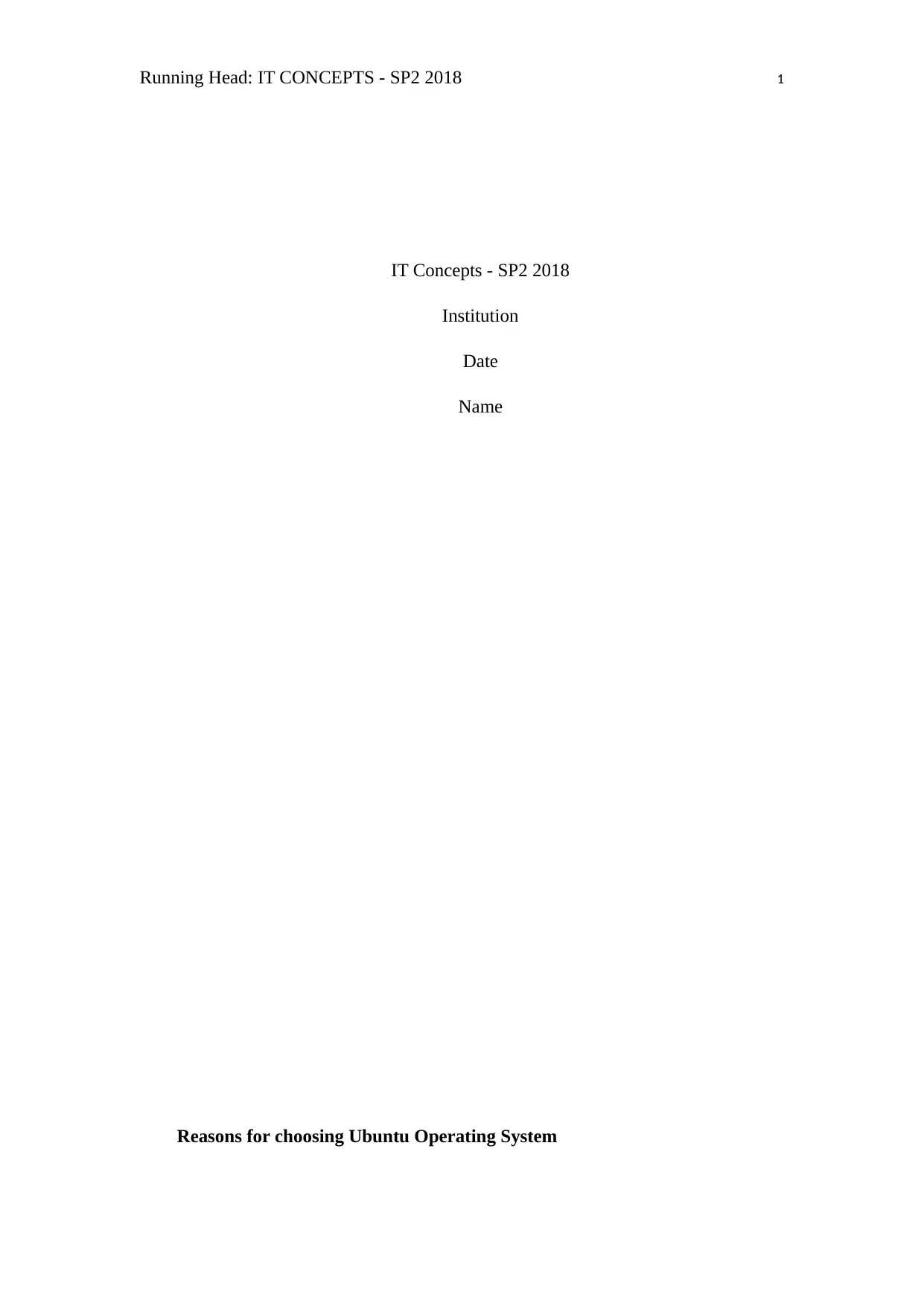
Running Head: IT CONCEPTS - SP2 2018 1
IT Concepts - SP2 2018
Institution
Date
Name
Reasons for choosing Ubuntu Operating System
IT Concepts - SP2 2018
Institution
Date
Name
Reasons for choosing Ubuntu Operating System
Secure Best Marks with AI Grader
Need help grading? Try our AI Grader for instant feedback on your assignments.
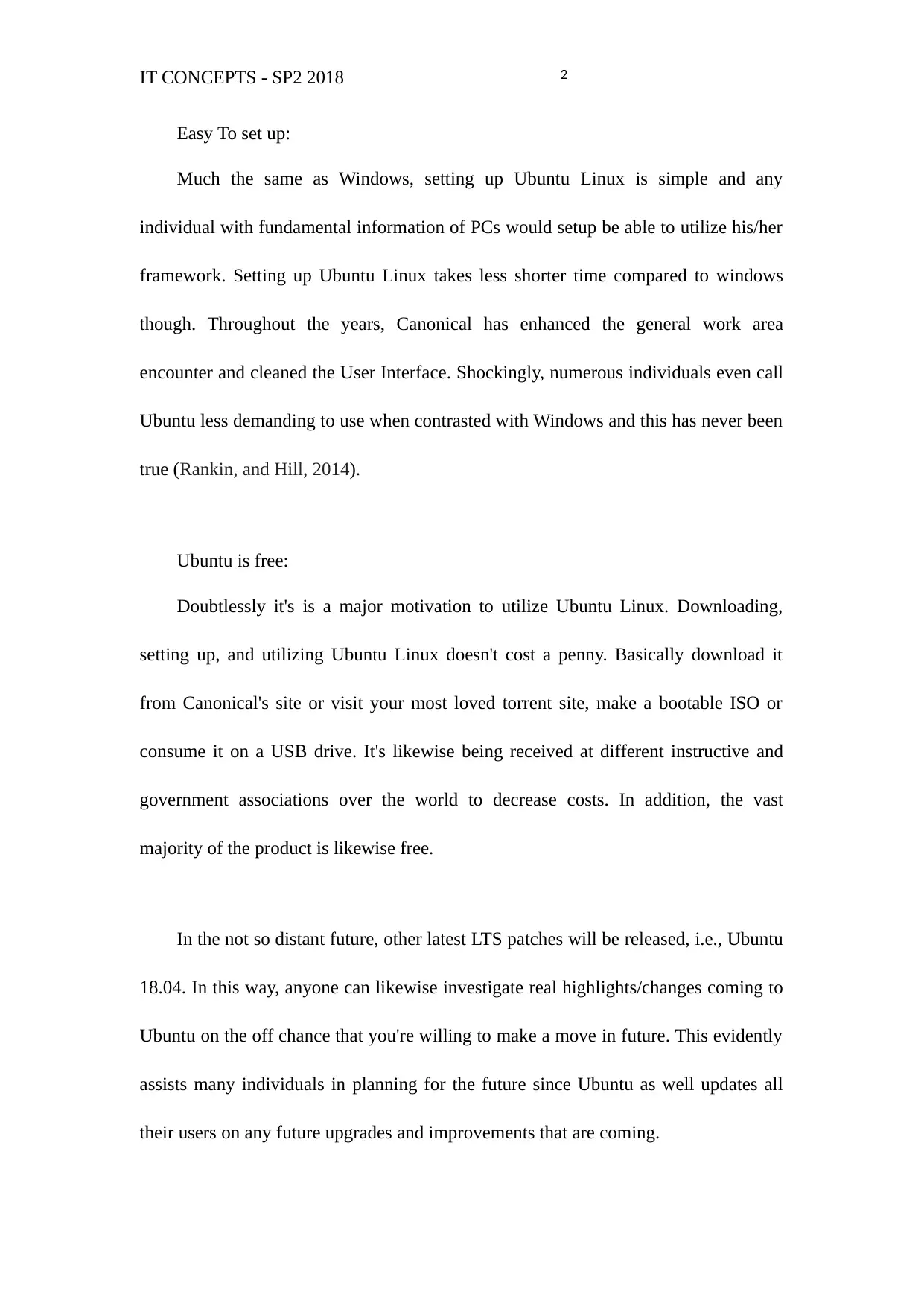
2IT CONCEPTS - SP2 2018
Easy To set up:
Much the same as Windows, setting up Ubuntu Linux is simple and any
individual with fundamental information of PCs would setup be able to utilize his/her
framework. Setting up Ubuntu Linux takes less shorter time compared to windows
though. Throughout the years, Canonical has enhanced the general work area
encounter and cleaned the User Interface. Shockingly, numerous individuals even call
Ubuntu less demanding to use when contrasted with Windows and this has never been
true (Rankin, and Hill, 2014).
Ubuntu is free:
Doubtlessly it's is a major motivation to utilize Ubuntu Linux. Downloading,
setting up, and utilizing Ubuntu Linux doesn't cost a penny. Basically download it
from Canonical's site or visit your most loved torrent site, make a bootable ISO or
consume it on a USB drive. It's likewise being received at different instructive and
government associations over the world to decrease costs. In addition, the vast
majority of the product is likewise free.
In the not so distant future, other latest LTS patches will be released, i.e., Ubuntu
18.04. In this way, anyone can likewise investigate real highlights/changes coming to
Ubuntu on the off chance that you're willing to make a move in future. This evidently
assists many individuals in planning for the future since Ubuntu as well updates all
their users on any future upgrades and improvements that are coming.
Easy To set up:
Much the same as Windows, setting up Ubuntu Linux is simple and any
individual with fundamental information of PCs would setup be able to utilize his/her
framework. Setting up Ubuntu Linux takes less shorter time compared to windows
though. Throughout the years, Canonical has enhanced the general work area
encounter and cleaned the User Interface. Shockingly, numerous individuals even call
Ubuntu less demanding to use when contrasted with Windows and this has never been
true (Rankin, and Hill, 2014).
Ubuntu is free:
Doubtlessly it's is a major motivation to utilize Ubuntu Linux. Downloading,
setting up, and utilizing Ubuntu Linux doesn't cost a penny. Basically download it
from Canonical's site or visit your most loved torrent site, make a bootable ISO or
consume it on a USB drive. It's likewise being received at different instructive and
government associations over the world to decrease costs. In addition, the vast
majority of the product is likewise free.
In the not so distant future, other latest LTS patches will be released, i.e., Ubuntu
18.04. In this way, anyone can likewise investigate real highlights/changes coming to
Ubuntu on the off chance that you're willing to make a move in future. This evidently
assists many individuals in planning for the future since Ubuntu as well updates all
their users on any future upgrades and improvements that are coming.
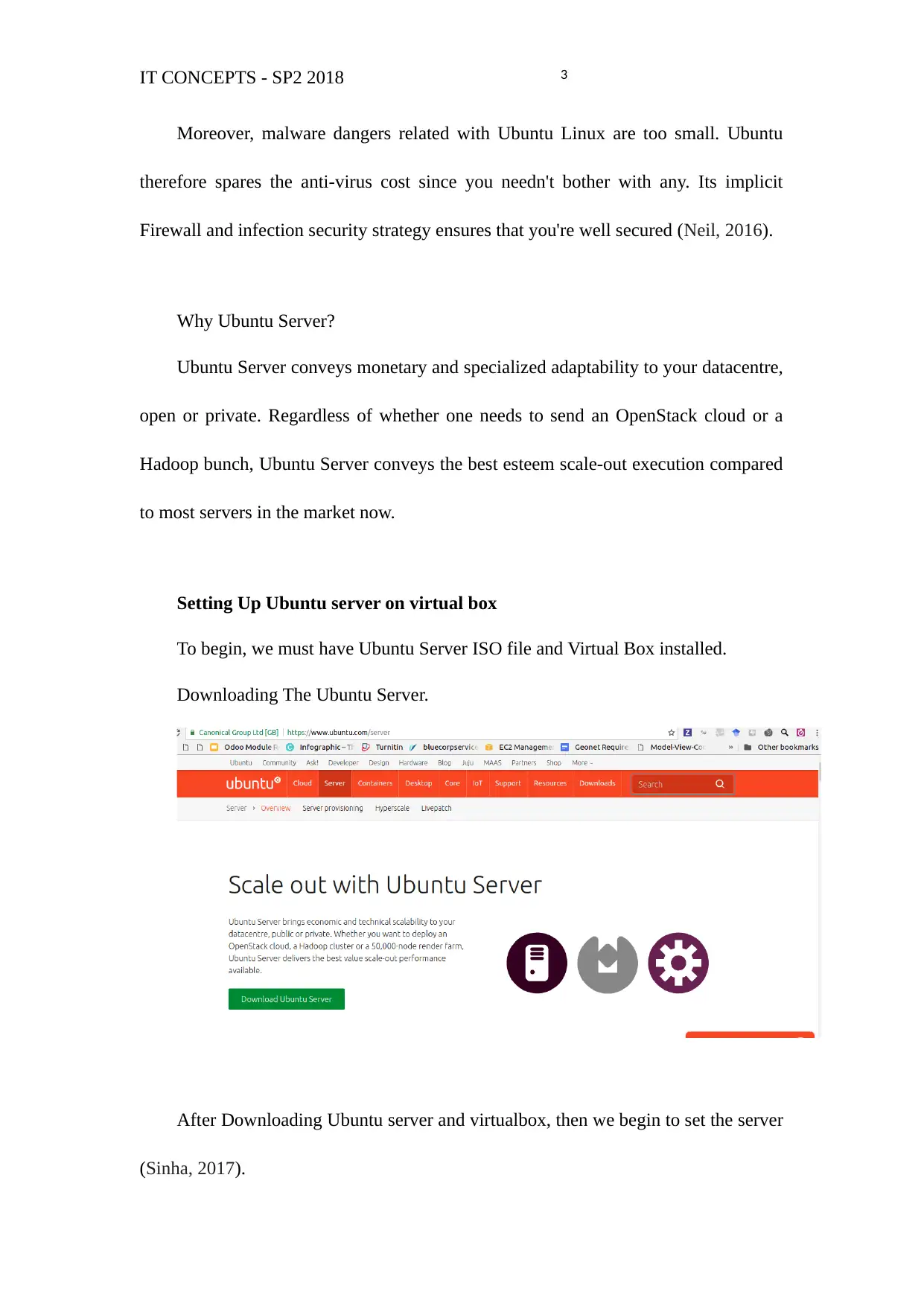
3IT CONCEPTS - SP2 2018
Moreover, malware dangers related with Ubuntu Linux are too small. Ubuntu
therefore spares the anti-virus cost since you needn't bother with any. Its implicit
Firewall and infection security strategy ensures that you're well secured (Neil, 2016).
Why Ubuntu Server?
Ubuntu Server conveys monetary and specialized adaptability to your datacentre,
open or private. Regardless of whether one needs to send an OpenStack cloud or a
Hadoop bunch, Ubuntu Server conveys the best esteem scale-out execution compared
to most servers in the market now.
Setting Up Ubuntu server on virtual box
To begin, we must have Ubuntu Server ISO file and Virtual Box installed.
Downloading The Ubuntu Server.
After Downloading Ubuntu server and virtualbox, then we begin to set the server
(Sinha, 2017).
Moreover, malware dangers related with Ubuntu Linux are too small. Ubuntu
therefore spares the anti-virus cost since you needn't bother with any. Its implicit
Firewall and infection security strategy ensures that you're well secured (Neil, 2016).
Why Ubuntu Server?
Ubuntu Server conveys monetary and specialized adaptability to your datacentre,
open or private. Regardless of whether one needs to send an OpenStack cloud or a
Hadoop bunch, Ubuntu Server conveys the best esteem scale-out execution compared
to most servers in the market now.
Setting Up Ubuntu server on virtual box
To begin, we must have Ubuntu Server ISO file and Virtual Box installed.
Downloading The Ubuntu Server.
After Downloading Ubuntu server and virtualbox, then we begin to set the server
(Sinha, 2017).
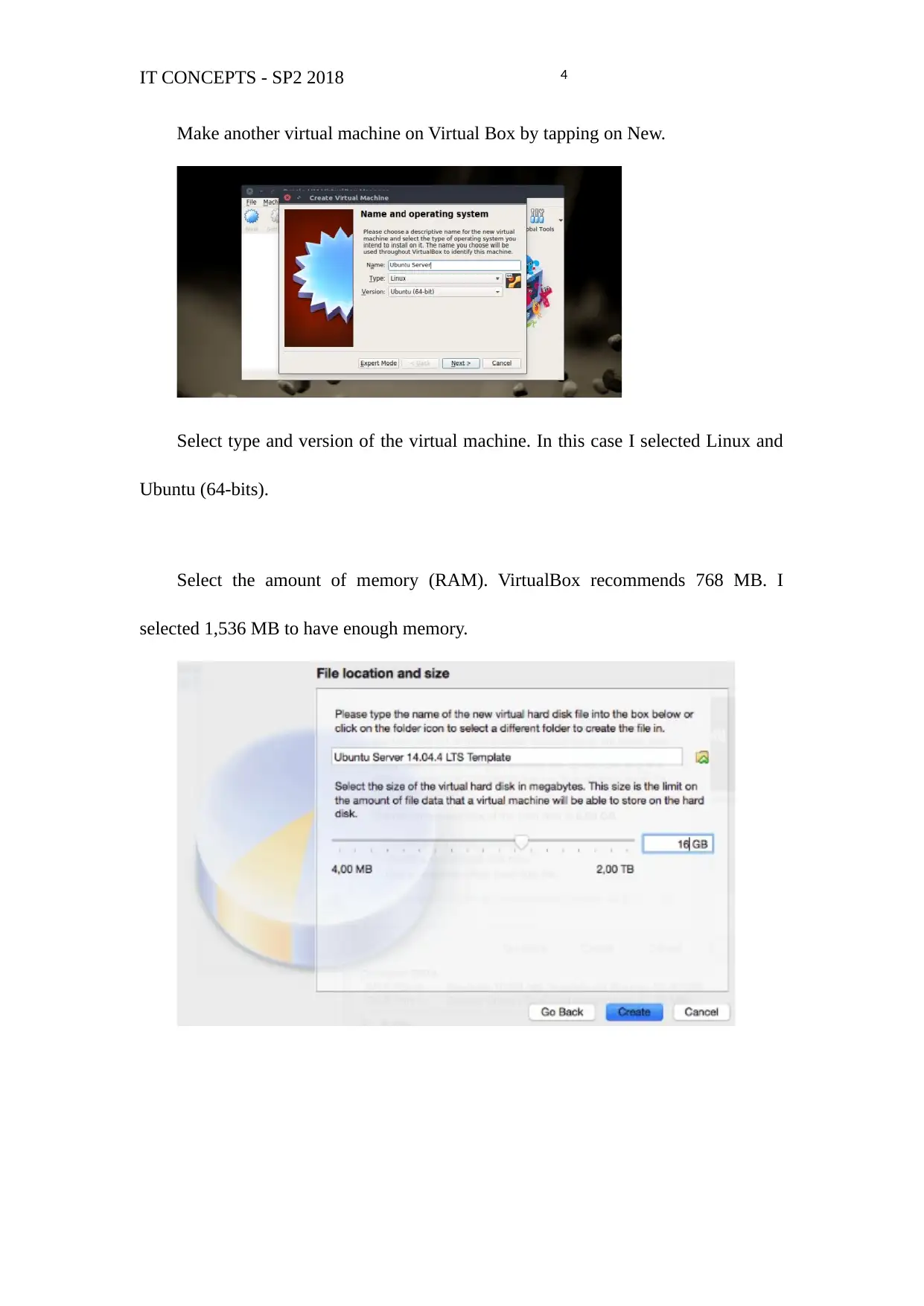
4IT CONCEPTS - SP2 2018
Make another virtual machine on Virtual Box by tapping on New.
Select type and version of the virtual machine. In this case I selected Linux and
Ubuntu (64-bits).
Select the amount of memory (RAM). VirtualBox recommends 768 MB. I
selected 1,536 MB to have enough memory.
Make another virtual machine on Virtual Box by tapping on New.
Select type and version of the virtual machine. In this case I selected Linux and
Ubuntu (64-bits).
Select the amount of memory (RAM). VirtualBox recommends 768 MB. I
selected 1,536 MB to have enough memory.
Secure Best Marks with AI Grader
Need help grading? Try our AI Grader for instant feedback on your assignments.
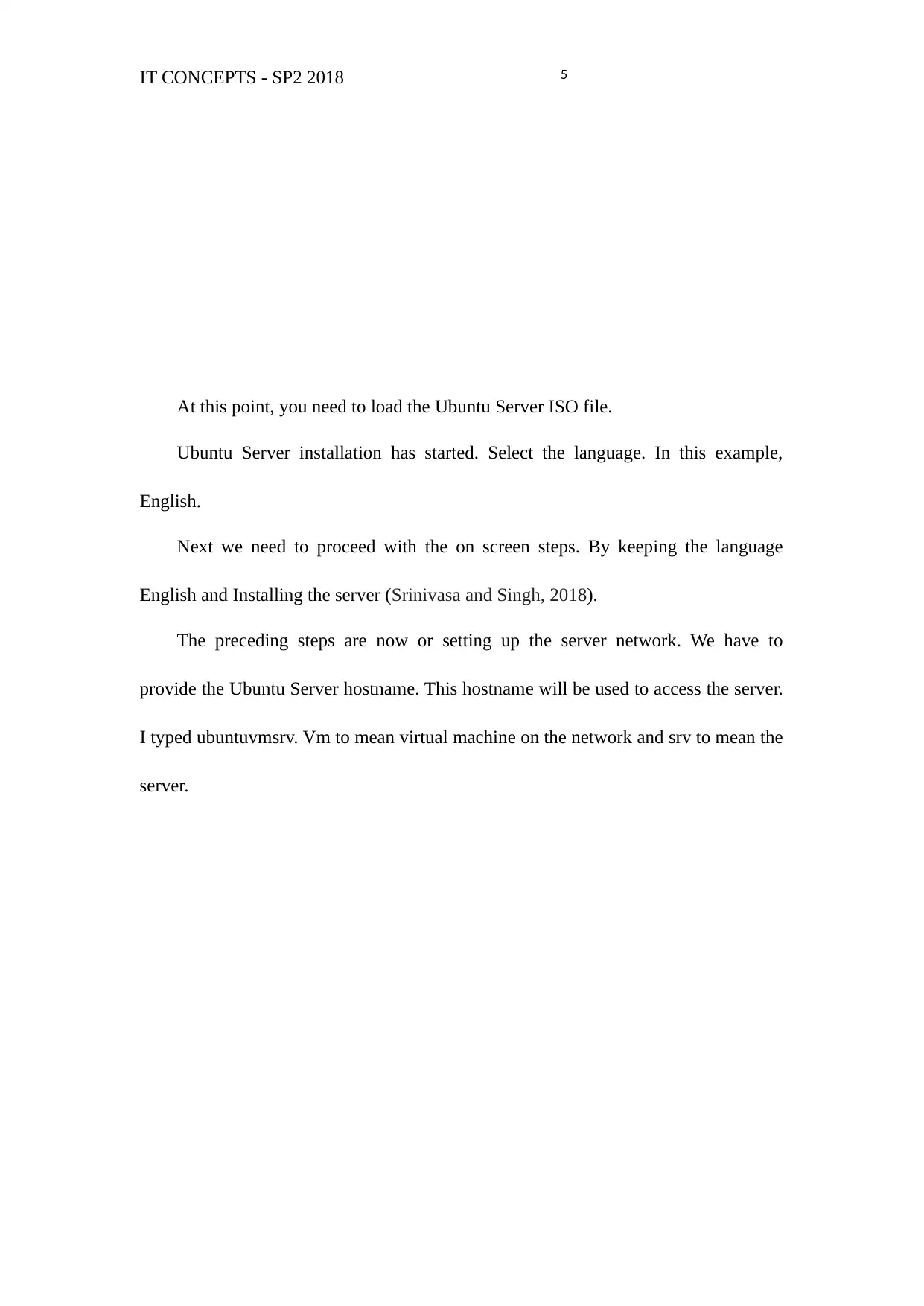
5IT CONCEPTS - SP2 2018
At this point, you need to load the Ubuntu Server ISO file.
Ubuntu Server installation has started. Select the language. In this example,
English.
Next we need to proceed with the on screen steps. By keeping the language
English and Installing the server (Srinivasa and Singh, 2018).
The preceding steps are now or setting up the server network. We have to
provide the Ubuntu Server hostname. This hostname will be used to access the server.
I typed ubuntuvmsrv. Vm to mean virtual machine on the network and srv to mean the
server.
At this point, you need to load the Ubuntu Server ISO file.
Ubuntu Server installation has started. Select the language. In this example,
English.
Next we need to proceed with the on screen steps. By keeping the language
English and Installing the server (Srinivasa and Singh, 2018).
The preceding steps are now or setting up the server network. We have to
provide the Ubuntu Server hostname. This hostname will be used to access the server.
I typed ubuntuvmsrv. Vm to mean virtual machine on the network and srv to mean the
server.
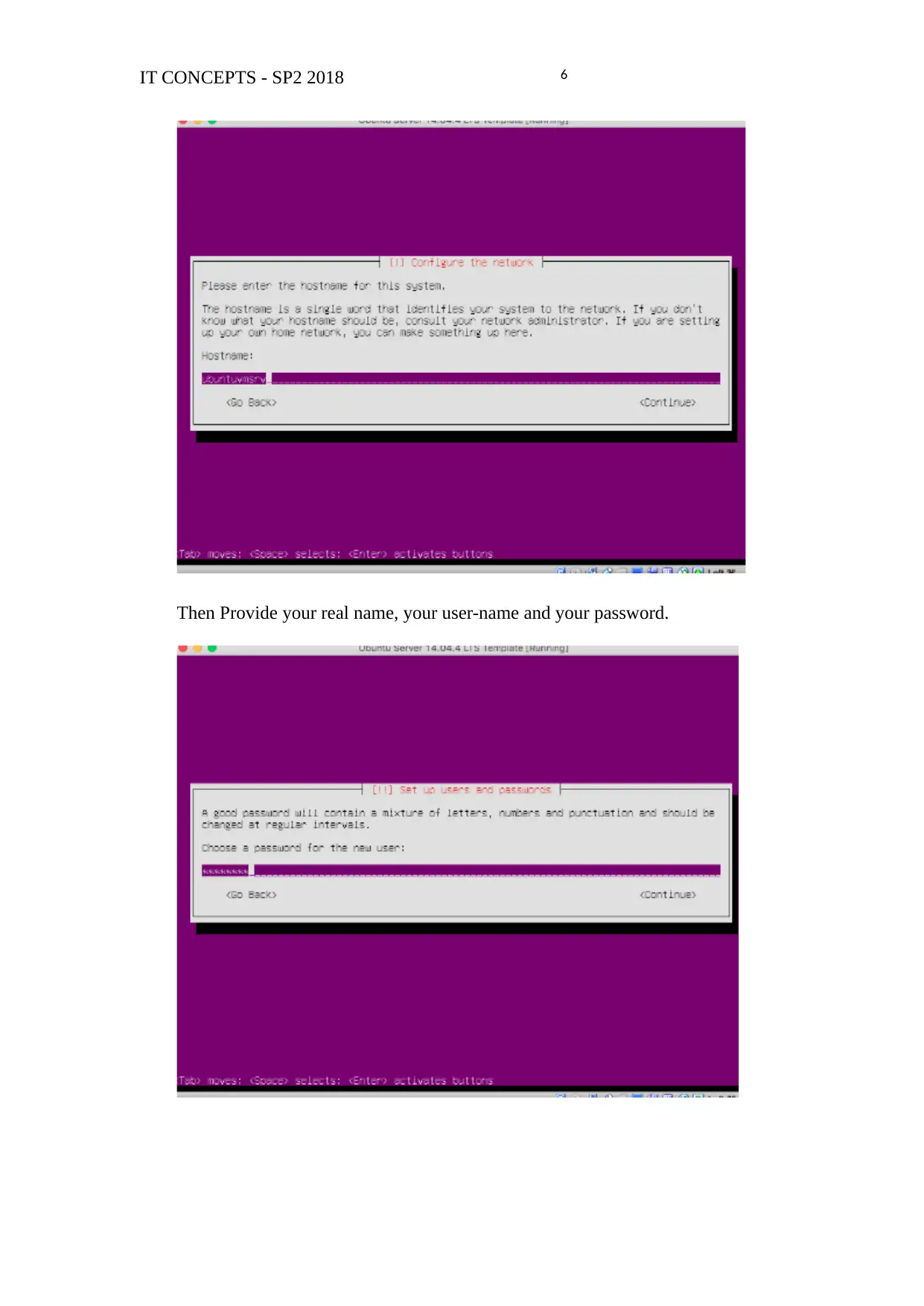
6IT CONCEPTS - SP2 2018
Then Provide your real name, your user-name and your password.
Then Provide your real name, your user-name and your password.

7IT CONCEPTS - SP2 2018
From Here also, Ubuntu can guide regarding partitions. This is a virtual machine
to test, so I selected Guided - use entire disk.
Configure updates as you want. I select manually updates.
From Here also, Ubuntu can guide regarding partitions. This is a virtual machine
to test, so I selected Guided - use entire disk.
Configure updates as you want. I select manually updates.
Paraphrase This Document
Need a fresh take? Get an instant paraphrase of this document with our AI Paraphraser
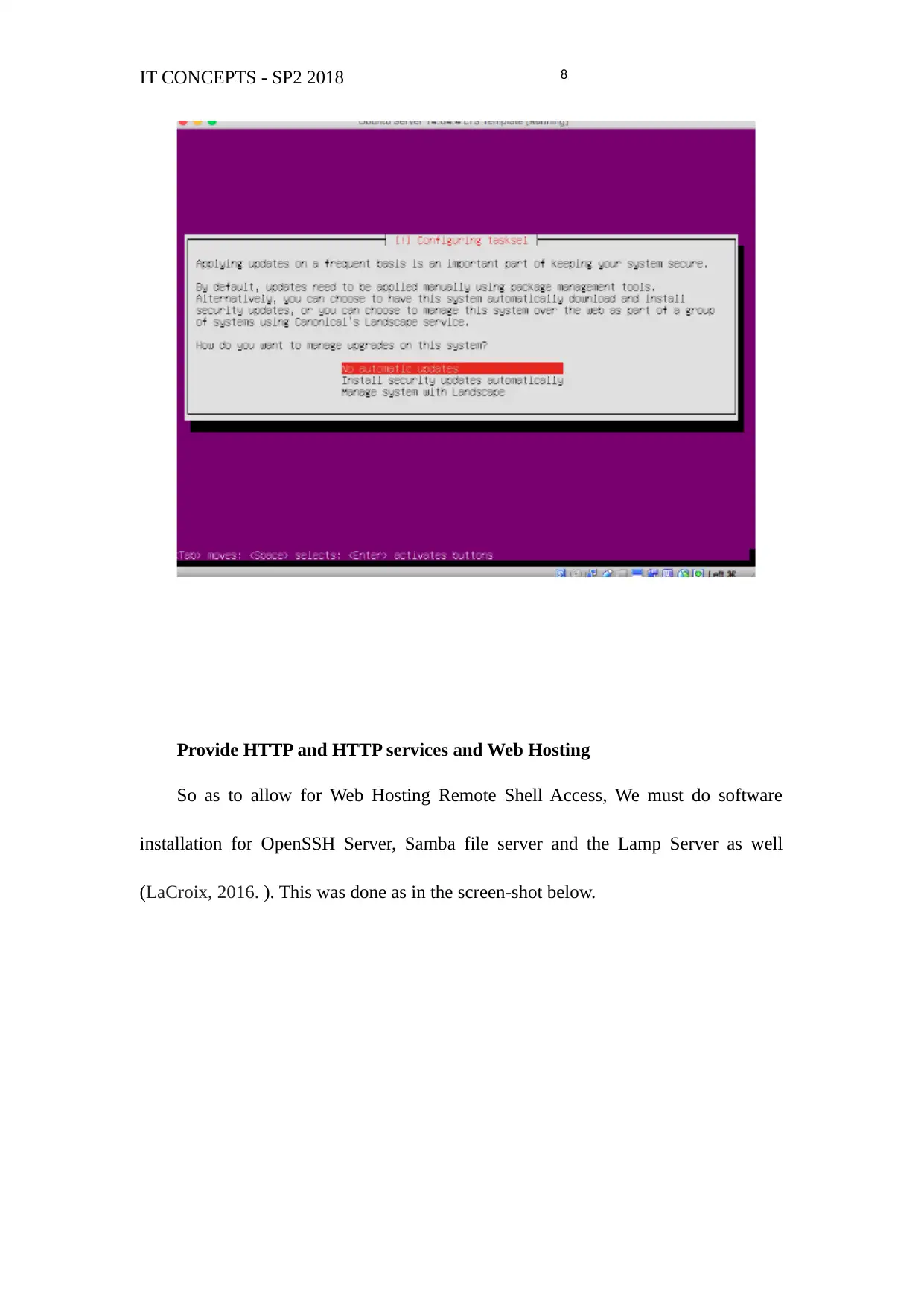
8IT CONCEPTS - SP2 2018
Provide HTTP and HTTP services and Web Hosting
So as to allow for Web Hosting Remote Shell Access, We must do software
installation for OpenSSH Server, Samba file server and the Lamp Server as well
(LaCroix, 2016. ). This was done as in the screen-shot below.
Provide HTTP and HTTP services and Web Hosting
So as to allow for Web Hosting Remote Shell Access, We must do software
installation for OpenSSH Server, Samba file server and the Lamp Server as well
(LaCroix, 2016. ). This was done as in the screen-shot below.
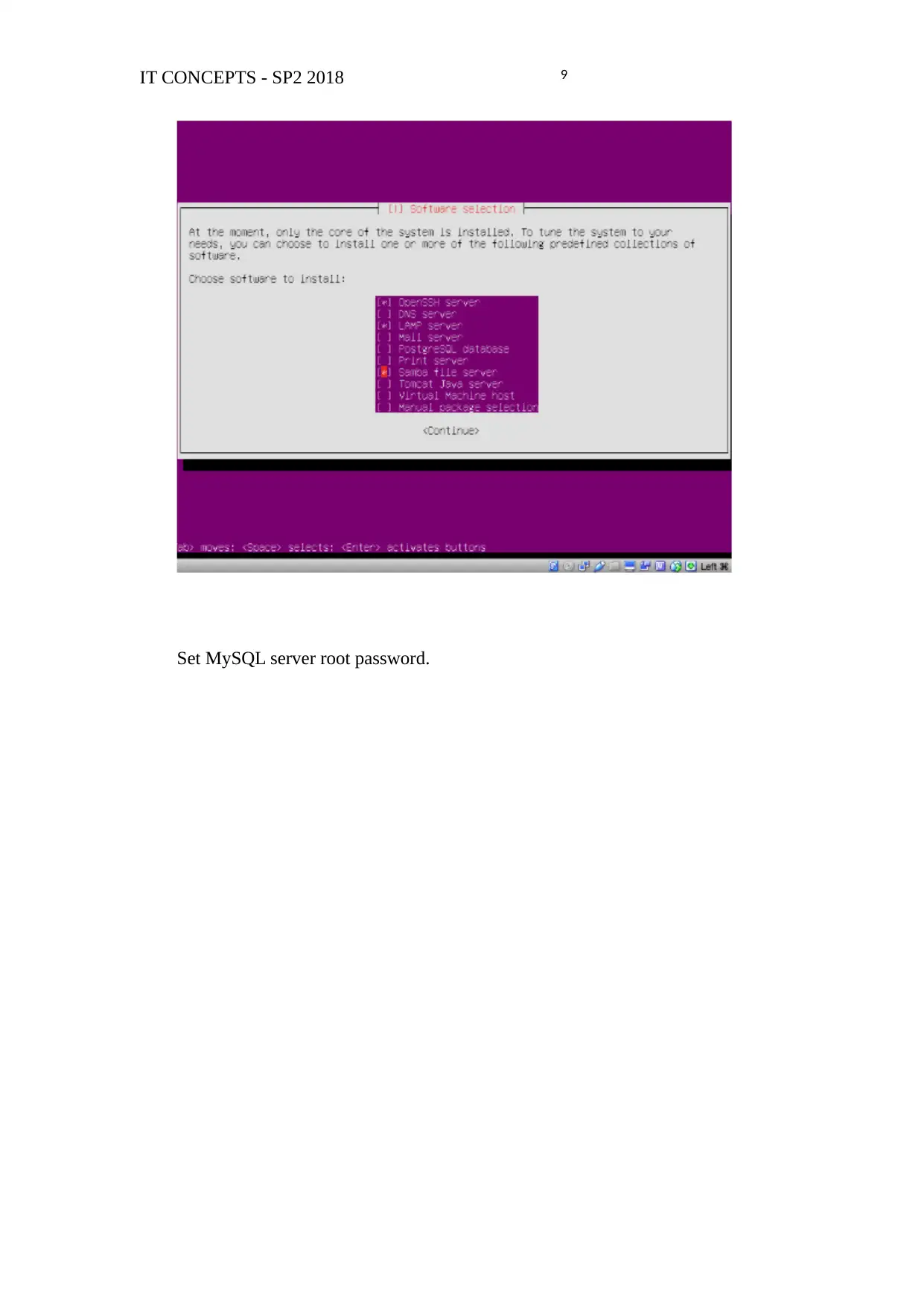
9IT CONCEPTS - SP2 2018
Set MySQL server root password.
Set MySQL server root password.
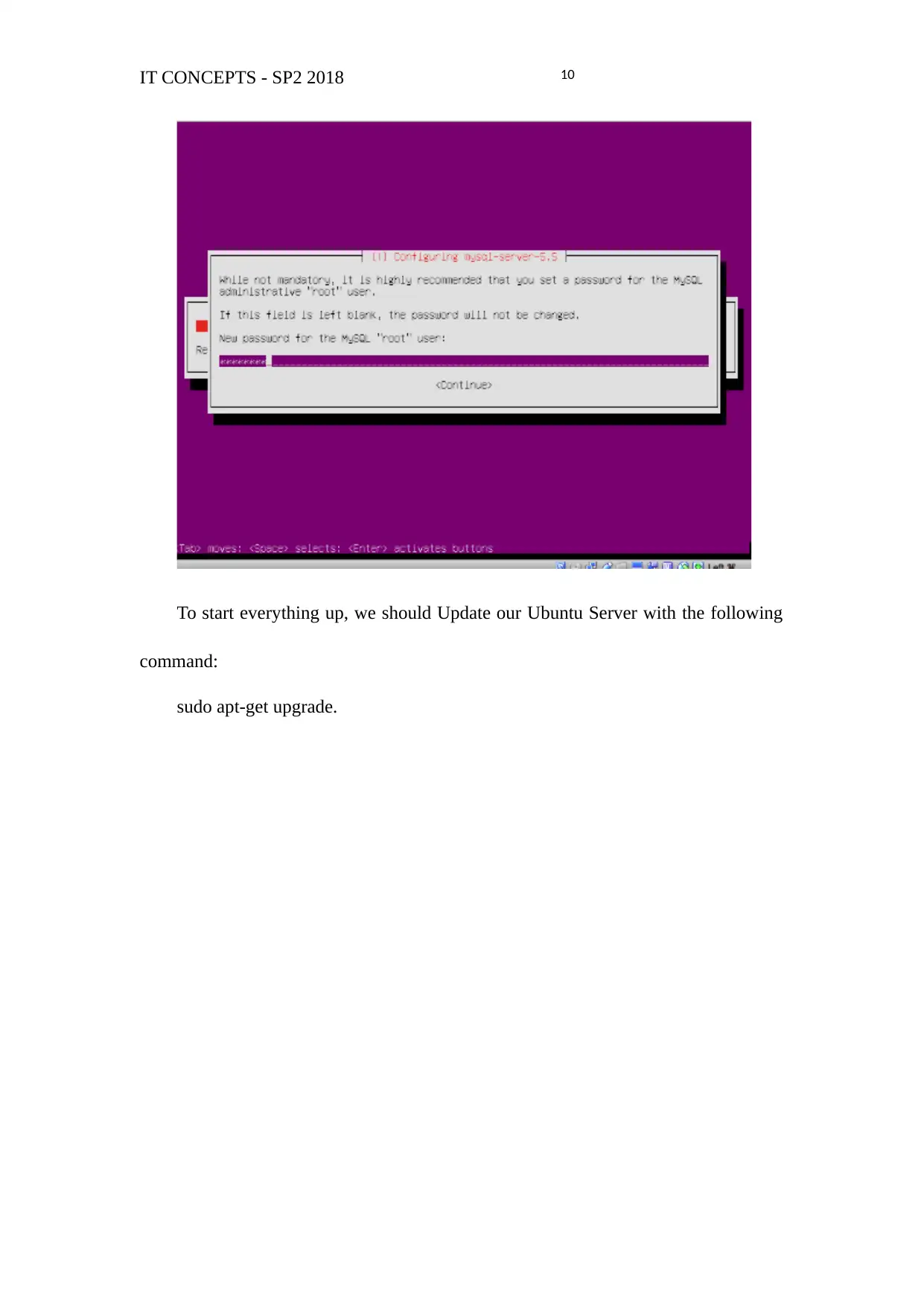
10IT CONCEPTS - SP2 2018
To start everything up, we should Update our Ubuntu Server with the following
command:
sudo apt-get upgrade.
To start everything up, we should Update our Ubuntu Server with the following
command:
sudo apt-get upgrade.
Secure Best Marks with AI Grader
Need help grading? Try our AI Grader for instant feedback on your assignments.
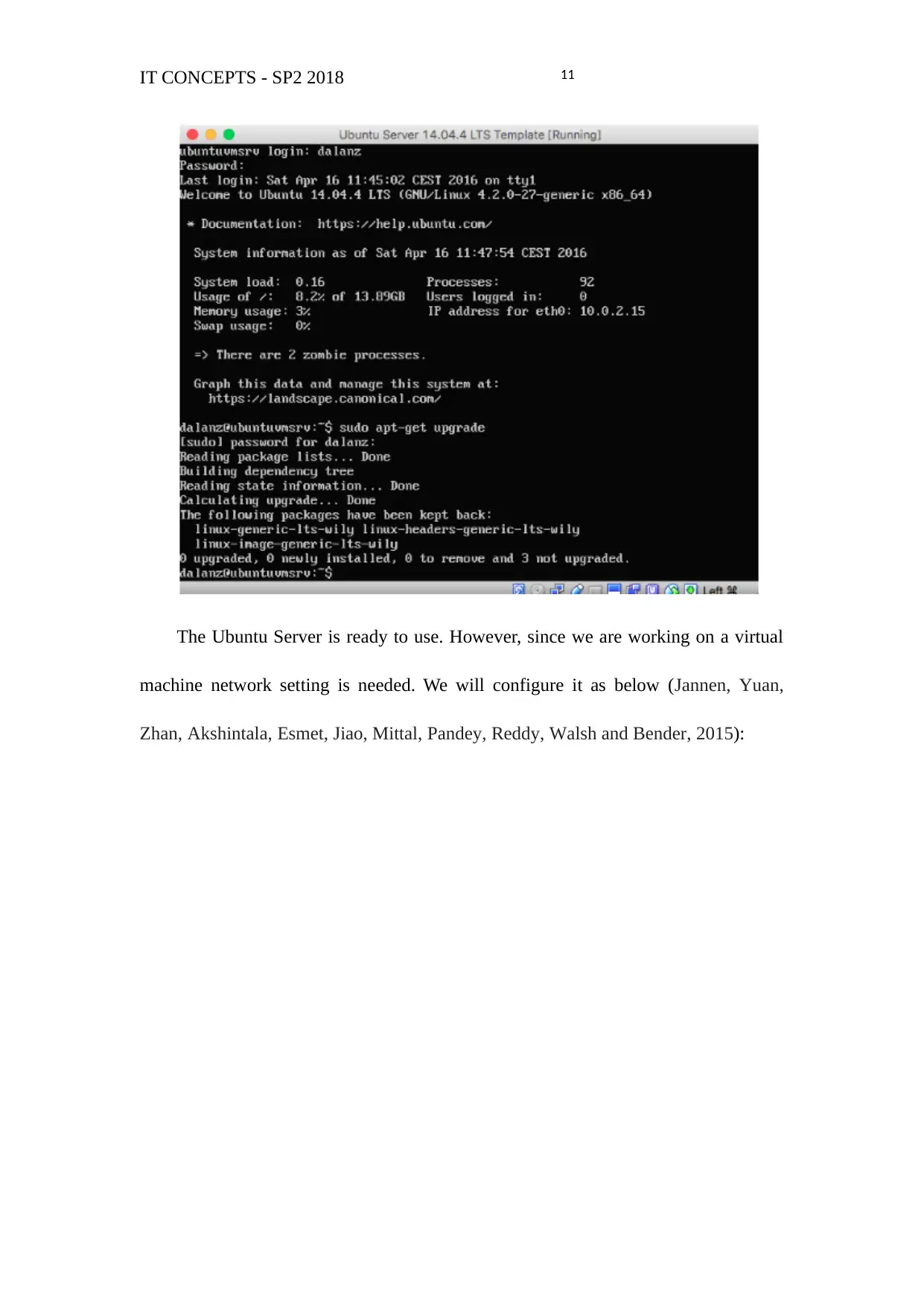
11IT CONCEPTS - SP2 2018
The Ubuntu Server is ready to use. However, since we are working on a virtual
machine network setting is needed. We will configure it as below (Jannen, Yuan,
Zhan, Akshintala, Esmet, Jiao, Mittal, Pandey, Reddy, Walsh and Bender, 2015):
The Ubuntu Server is ready to use. However, since we are working on a virtual
machine network setting is needed. We will configure it as below (Jannen, Yuan,
Zhan, Akshintala, Esmet, Jiao, Mittal, Pandey, Reddy, Walsh and Bender, 2015):
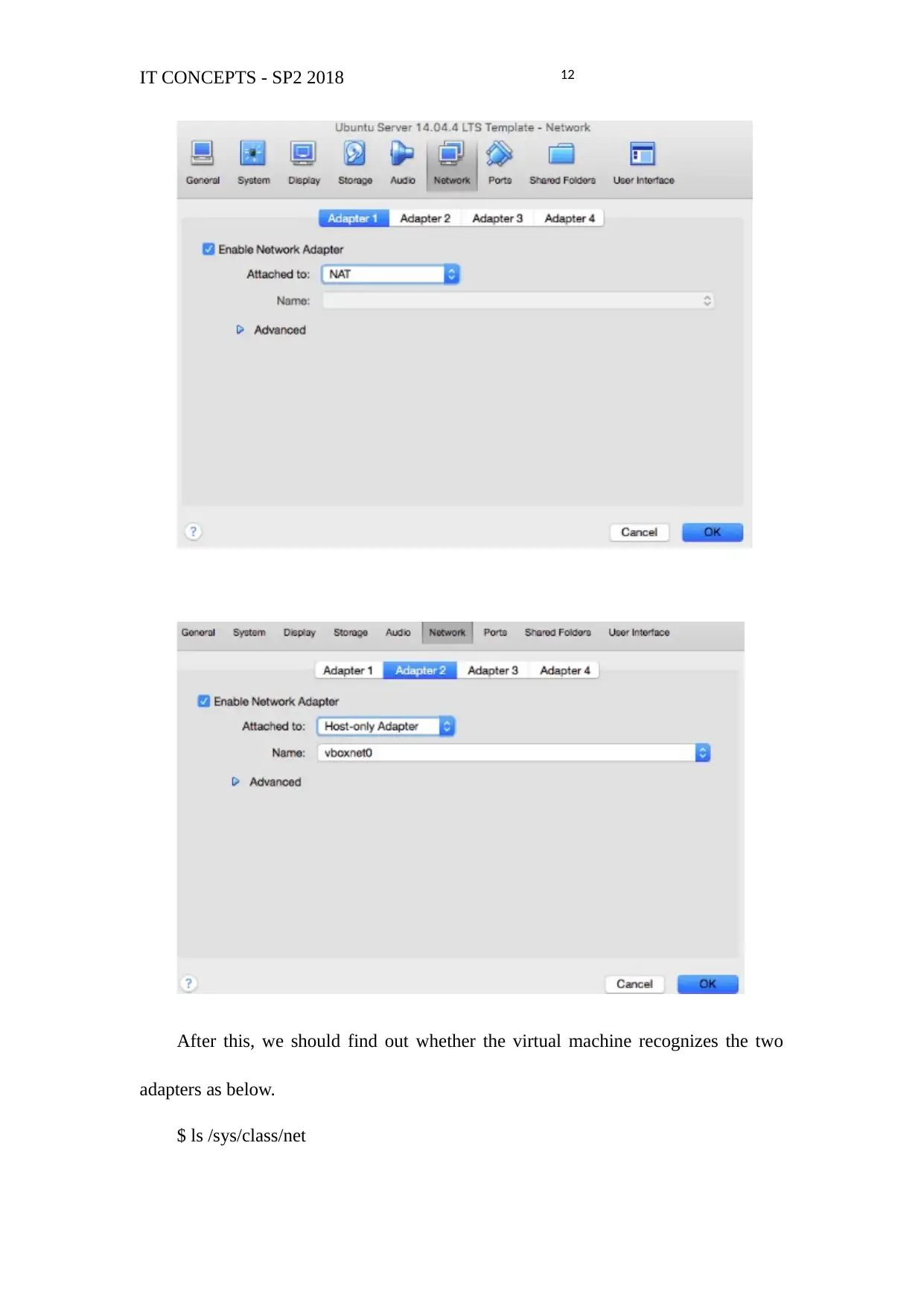
12IT CONCEPTS - SP2 2018
After this, we should find out whether the virtual machine recognizes the two
adapters as below.
$ ls /sys/class/net
After this, we should find out whether the virtual machine recognizes the two
adapters as below.
$ ls /sys/class/net
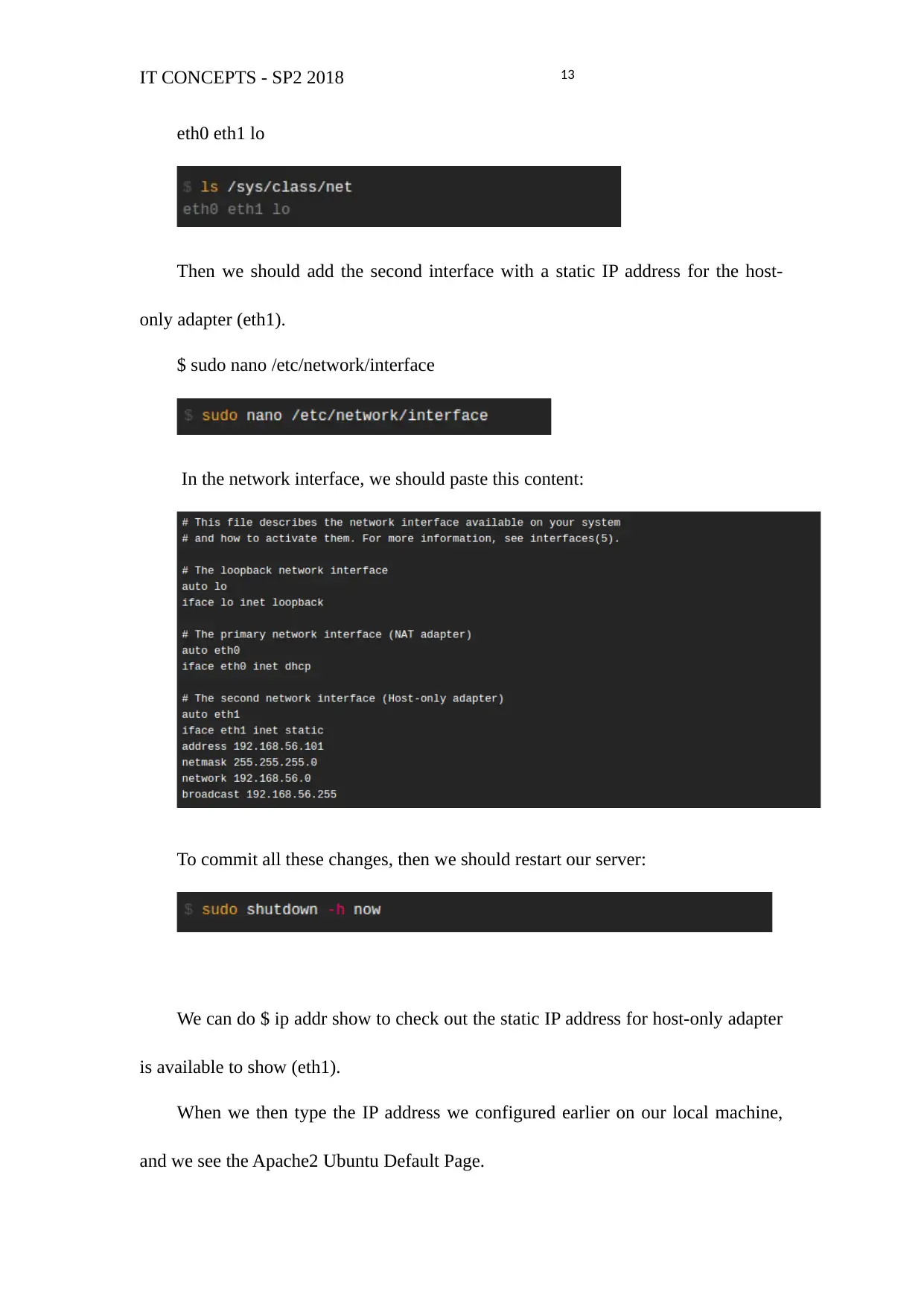
13IT CONCEPTS - SP2 2018
eth0 eth1 lo
Then we should add the second interface with a static IP address for the host-
only adapter (eth1).
$ sudo nano /etc/network/interface
In the network interface, we should paste this content:
To commit all these changes, then we should restart our server:
We can do $ ip addr show to check out the static IP address for host-only adapter
is available to show (eth1).
When we then type the IP address we configured earlier on our local machine,
and we see the Apache2 Ubuntu Default Page.
eth0 eth1 lo
Then we should add the second interface with a static IP address for the host-
only adapter (eth1).
$ sudo nano /etc/network/interface
In the network interface, we should paste this content:
To commit all these changes, then we should restart our server:
We can do $ ip addr show to check out the static IP address for host-only adapter
is available to show (eth1).
When we then type the IP address we configured earlier on our local machine,
and we see the Apache2 Ubuntu Default Page.
Paraphrase This Document
Need a fresh take? Get an instant paraphrase of this document with our AI Paraphraser
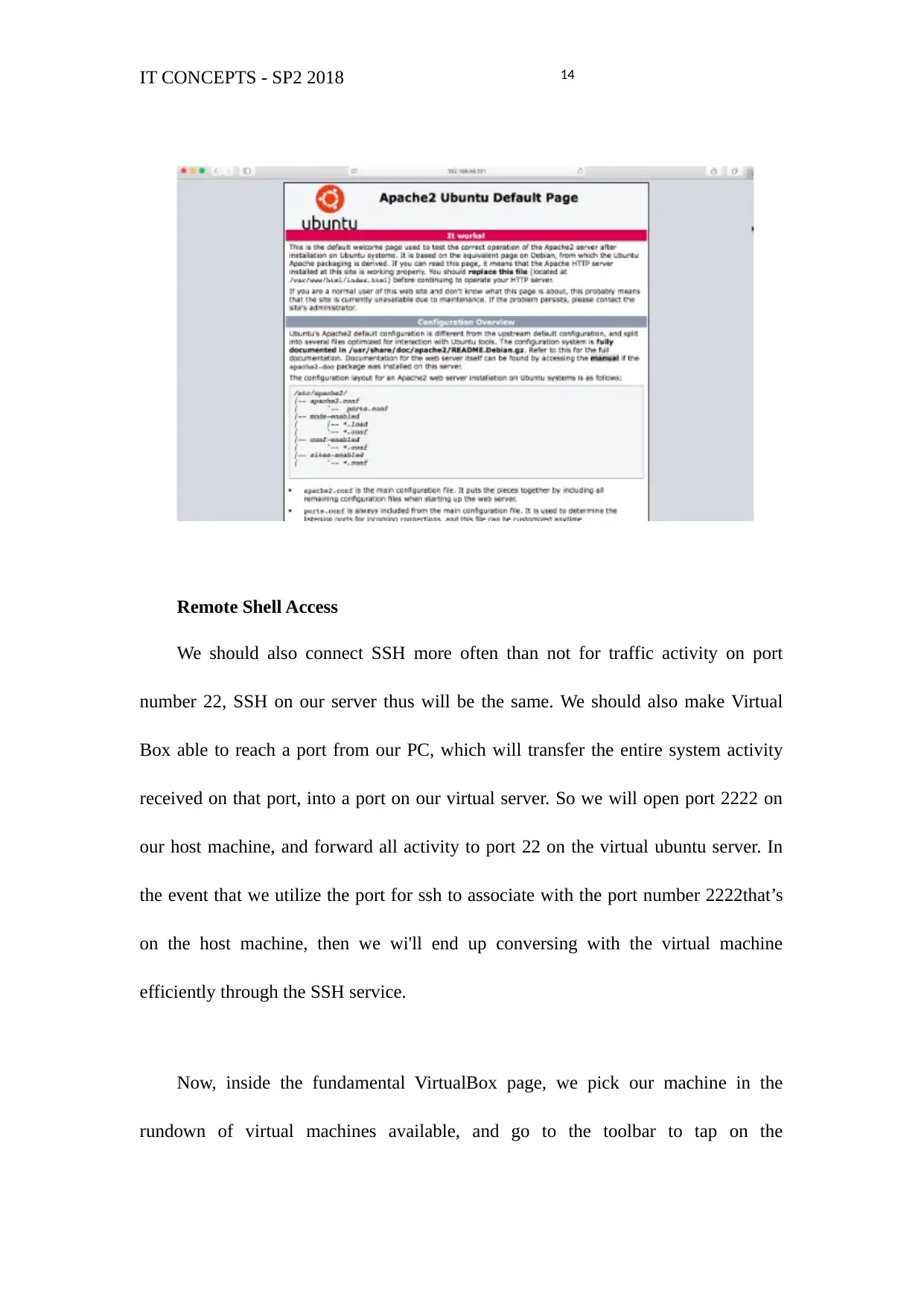
14IT CONCEPTS - SP2 2018
Remote Shell Access
We should also connect SSH more often than not for traffic activity on port
number 22, SSH on our server thus will be the same. We should also make Virtual
Box able to reach a port from our PC, which will transfer the entire system activity
received on that port, into a port on our virtual server. So we will open port 2222 on
our host machine, and forward all activity to port 22 on the virtual ubuntu server. In
the event that we utilize the port for ssh to associate with the port number 2222that’s
on the host machine, then we wi'll end up conversing with the virtual machine
efficiently through the SSH service.
Now, inside the fundamental VirtualBox page, we pick our machine in the
rundown of virtual machines available, and go to the toolbar to tap on the
Remote Shell Access
We should also connect SSH more often than not for traffic activity on port
number 22, SSH on our server thus will be the same. We should also make Virtual
Box able to reach a port from our PC, which will transfer the entire system activity
received on that port, into a port on our virtual server. So we will open port 2222 on
our host machine, and forward all activity to port 22 on the virtual ubuntu server. In
the event that we utilize the port for ssh to associate with the port number 2222that’s
on the host machine, then we wi'll end up conversing with the virtual machine
efficiently through the SSH service.
Now, inside the fundamental VirtualBox page, we pick our machine in the
rundown of virtual machines available, and go to the toolbar to tap on the
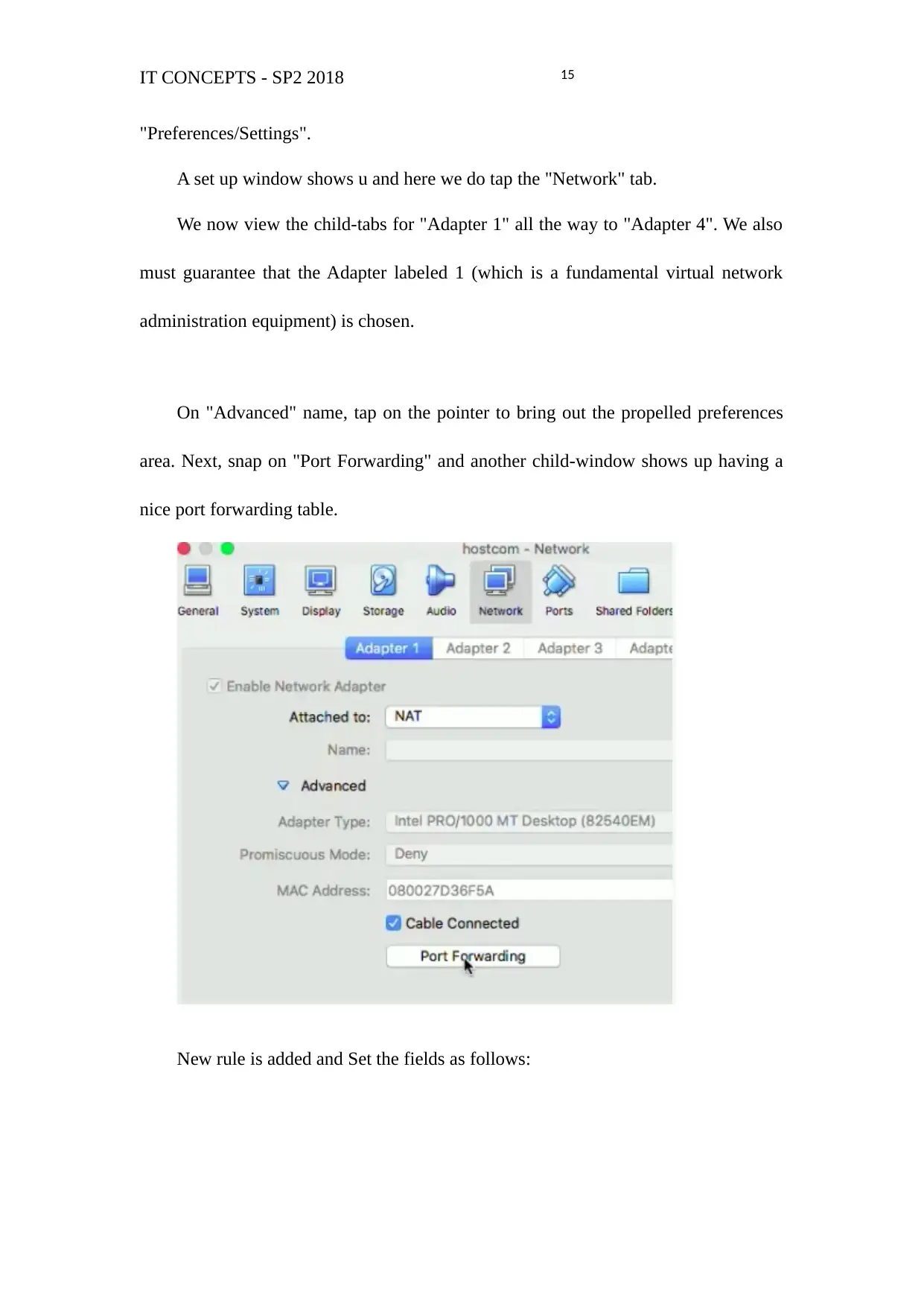
15IT CONCEPTS - SP2 2018
"Preferences/Settings".
A set up window shows u and here we do tap the "Network" tab.
We now view the child-tabs for "Adapter 1" all the way to "Adapter 4". We also
must guarantee that the Adapter labeled 1 (which is a fundamental virtual network
administration equipment) is chosen.
On "Advanced" name, tap on the pointer to bring out the propelled preferences
area. Next, snap on "Port Forwarding" and another child-window shows up having a
nice port forwarding table.
New rule is added and Set the fields as follows:
"Preferences/Settings".
A set up window shows u and here we do tap the "Network" tab.
We now view the child-tabs for "Adapter 1" all the way to "Adapter 4". We also
must guarantee that the Adapter labeled 1 (which is a fundamental virtual network
administration equipment) is chosen.
On "Advanced" name, tap on the pointer to bring out the propelled preferences
area. Next, snap on "Port Forwarding" and another child-window shows up having a
nice port forwarding table.
New rule is added and Set the fields as follows:
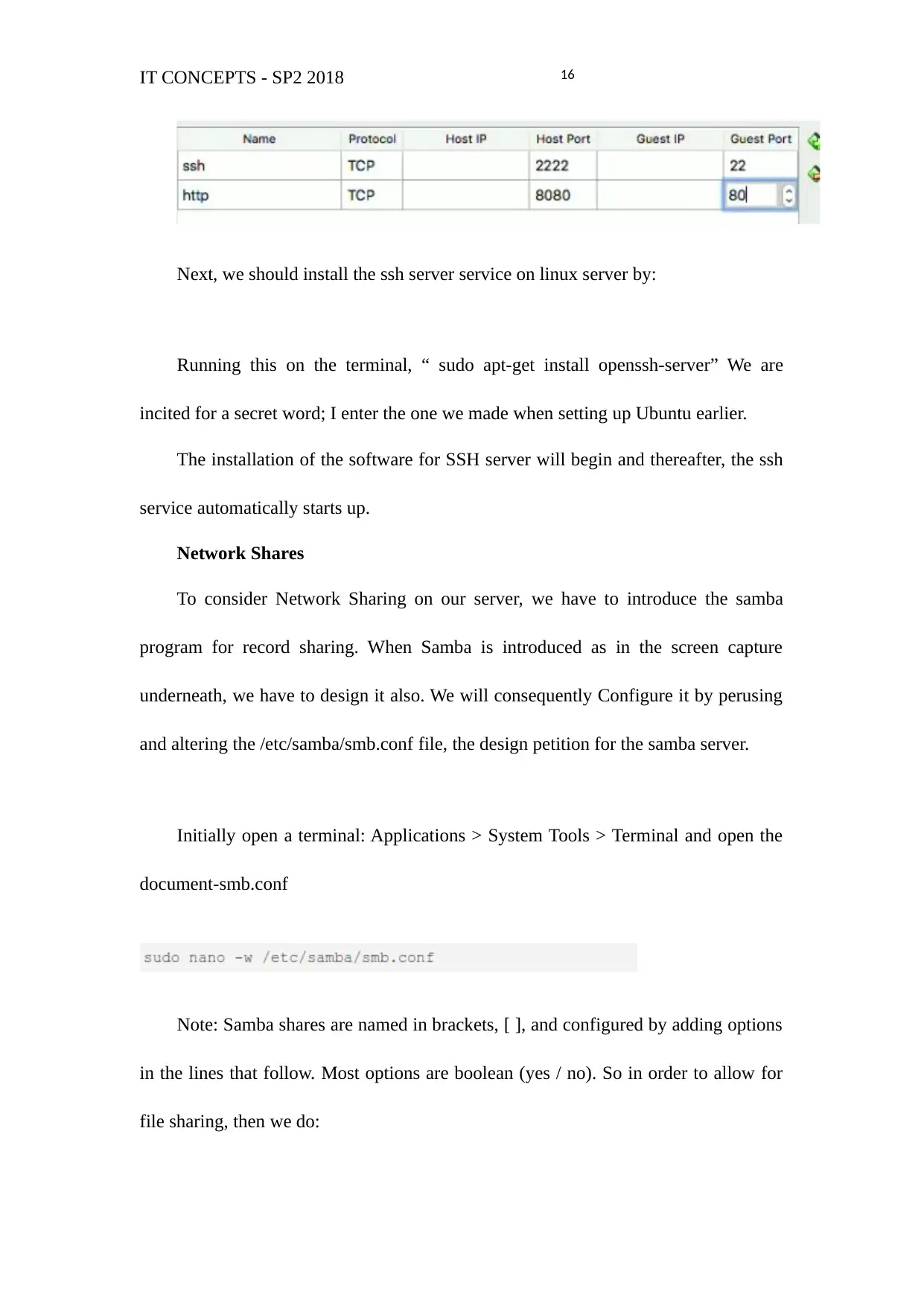
16IT CONCEPTS - SP2 2018
Next, we should install the ssh server service on linux server by:
Running this on the terminal, “ sudo apt-get install openssh-server” We are
incited for a secret word; I enter the one we made when setting up Ubuntu earlier.
The installation of the software for SSH server will begin and thereafter, the ssh
service automatically starts up.
Network Shares
To consider Network Sharing on our server, we have to introduce the samba
program for record sharing. When Samba is introduced as in the screen capture
underneath, we have to design it also. We will consequently Configure it by perusing
and altering the /etc/samba/smb.conf file, the design petition for the samba server.
Initially open a terminal: Applications > System Tools > Terminal and open the
document-smb.conf
Note: Samba shares are named in brackets, [ ], and configured by adding options
in the lines that follow. Most options are boolean (yes / no). So in order to allow for
file sharing, then we do:
Next, we should install the ssh server service on linux server by:
Running this on the terminal, “ sudo apt-get install openssh-server” We are
incited for a secret word; I enter the one we made when setting up Ubuntu earlier.
The installation of the software for SSH server will begin and thereafter, the ssh
service automatically starts up.
Network Shares
To consider Network Sharing on our server, we have to introduce the samba
program for record sharing. When Samba is introduced as in the screen capture
underneath, we have to design it also. We will consequently Configure it by perusing
and altering the /etc/samba/smb.conf file, the design petition for the samba server.
Initially open a terminal: Applications > System Tools > Terminal and open the
document-smb.conf
Note: Samba shares are named in brackets, [ ], and configured by adding options
in the lines that follow. Most options are boolean (yes / no). So in order to allow for
file sharing, then we do:
Secure Best Marks with AI Grader
Need help grading? Try our AI Grader for instant feedback on your assignments.
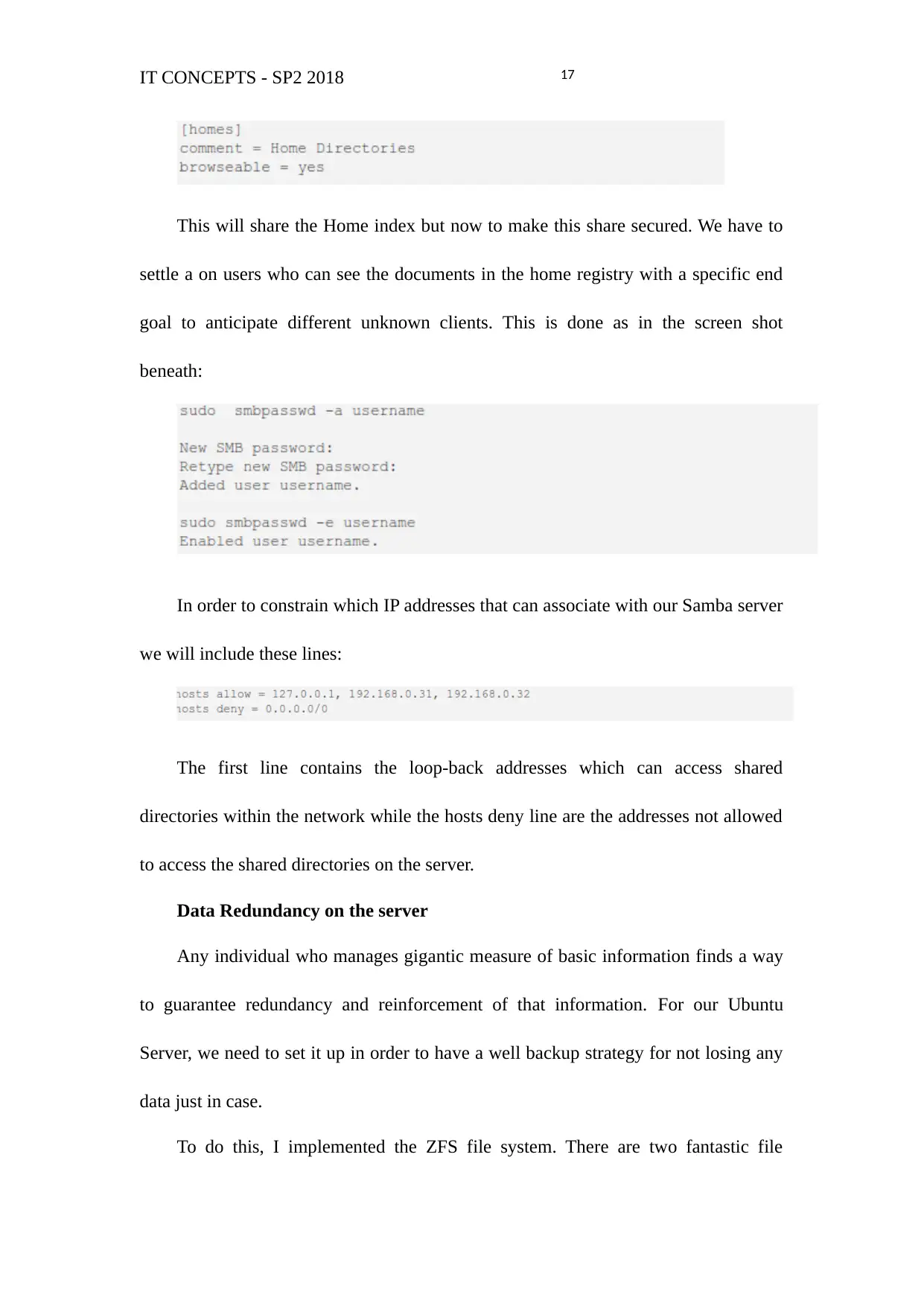
17IT CONCEPTS - SP2 2018
This will share the Home index but now to make this share secured. We have to
settle a on users who can see the documents in the home registry with a specific end
goal to anticipate different unknown clients. This is done as in the screen shot
beneath:
In order to constrain which IP addresses that can associate with our Samba server
we will include these lines:
The first line contains the loop-back addresses which can access shared
directories within the network while the hosts deny line are the addresses not allowed
to access the shared directories on the server.
Data Redundancy on the server
Any individual who manages gigantic measure of basic information finds a way
to guarantee redundancy and reinforcement of that information. For our Ubuntu
Server, we need to set it up in order to have a well backup strategy for not losing any
data just in case.
To do this, I implemented the ZFS file system. There are two fantastic file
This will share the Home index but now to make this share secured. We have to
settle a on users who can see the documents in the home registry with a specific end
goal to anticipate different unknown clients. This is done as in the screen shot
beneath:
In order to constrain which IP addresses that can associate with our Samba server
we will include these lines:
The first line contains the loop-back addresses which can access shared
directories within the network while the hosts deny line are the addresses not allowed
to access the shared directories on the server.
Data Redundancy on the server
Any individual who manages gigantic measure of basic information finds a way
to guarantee redundancy and reinforcement of that information. For our Ubuntu
Server, we need to set it up in order to have a well backup strategy for not losing any
data just in case.
To do this, I implemented the ZFS file system. There are two fantastic file
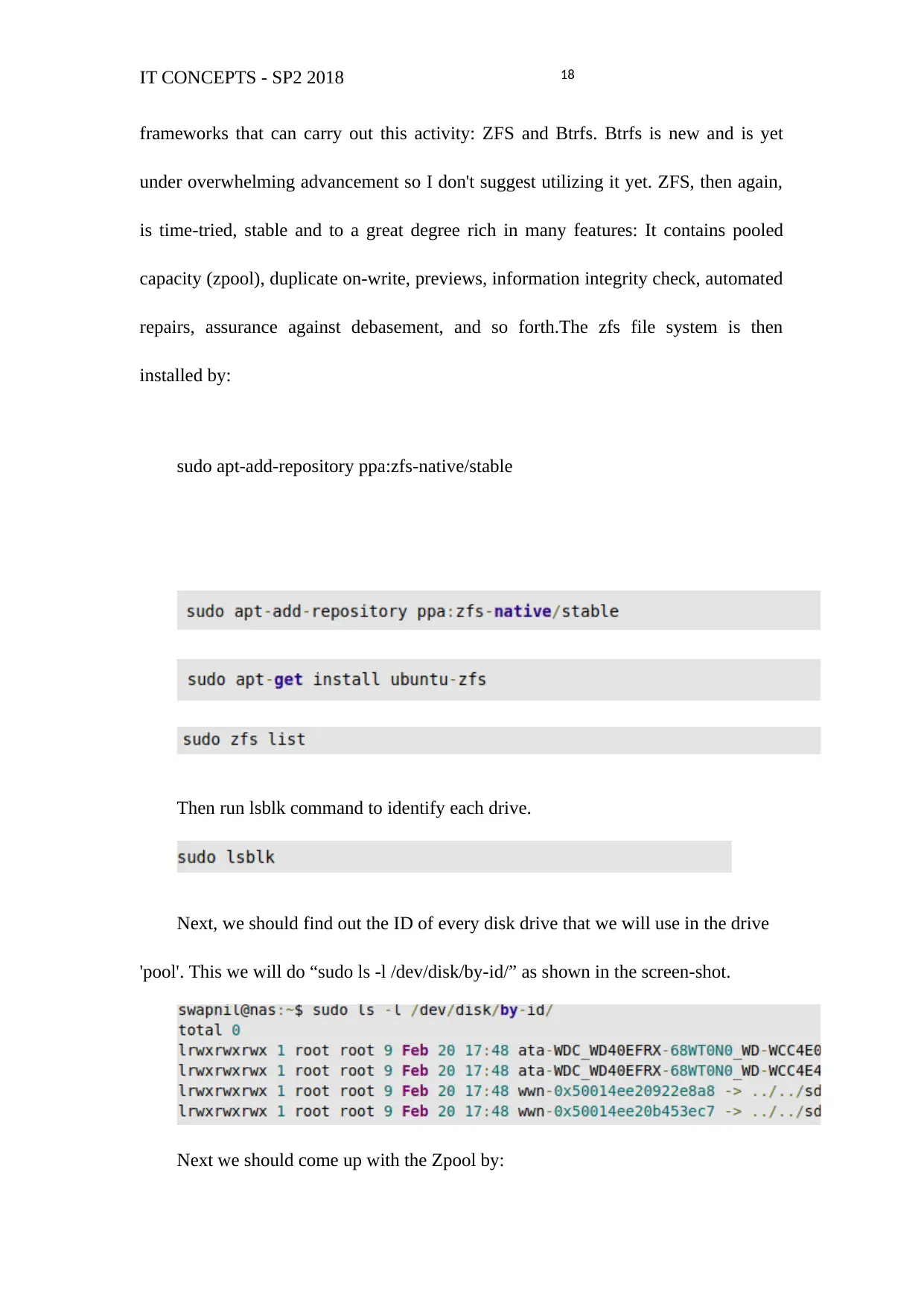
18IT CONCEPTS - SP2 2018
frameworks that can carry out this activity: ZFS and Btrfs. Btrfs is new and is yet
under overwhelming advancement so I don't suggest utilizing it yet. ZFS, then again,
is time-tried, stable and to a great degree rich in many features: It contains pooled
capacity (zpool), duplicate on-write, previews, information integrity check, automated
repairs, assurance against debasement, and so forth.The zfs file system is then
installed by:
sudo apt-add-repository ppa:zfs-native/stable
Then run lsblk command to identify each drive.
Next, we should find out the ID of every disk drive that we will use in the drive
'pool'. This we will do “sudo ls -l /dev/disk/by-id/” as shown in the screen-shot.
Next we should come up with the Zpool by:
frameworks that can carry out this activity: ZFS and Btrfs. Btrfs is new and is yet
under overwhelming advancement so I don't suggest utilizing it yet. ZFS, then again,
is time-tried, stable and to a great degree rich in many features: It contains pooled
capacity (zpool), duplicate on-write, previews, information integrity check, automated
repairs, assurance against debasement, and so forth.The zfs file system is then
installed by:
sudo apt-add-repository ppa:zfs-native/stable
Then run lsblk command to identify each drive.
Next, we should find out the ID of every disk drive that we will use in the drive
'pool'. This we will do “sudo ls -l /dev/disk/by-id/” as shown in the screen-shot.
Next we should come up with the Zpool by:
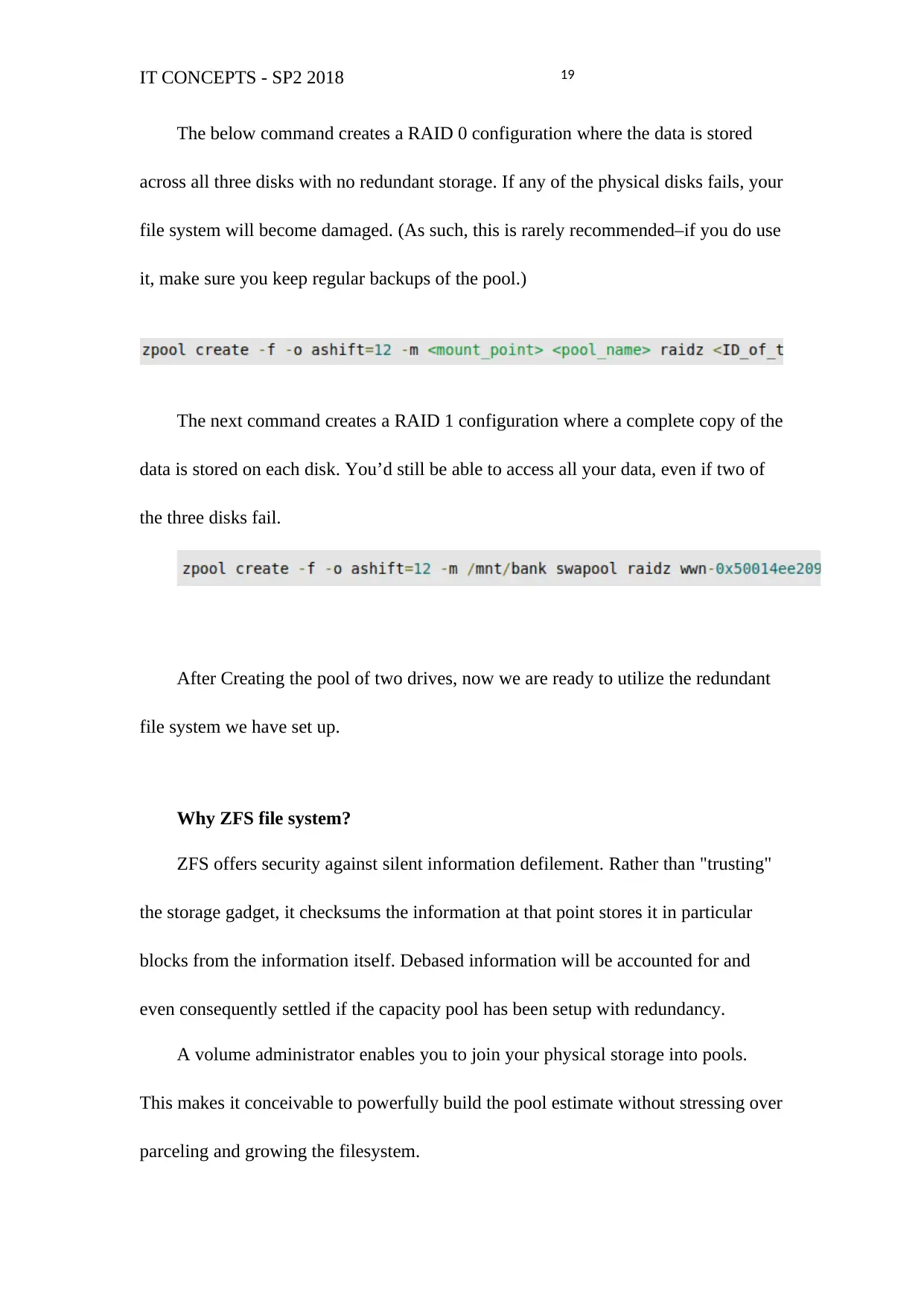
19IT CONCEPTS - SP2 2018
The below command creates a RAID 0 configuration where the data is stored
across all three disks with no redundant storage. If any of the physical disks fails, your
file system will become damaged. (As such, this is rarely recommended–if you do use
it, make sure you keep regular backups of the pool.)
The next command creates a RAID 1 configuration where a complete copy of the
data is stored on each disk. You’d still be able to access all your data, even if two of
the three disks fail.
After Creating the pool of two drives, now we are ready to utilize the redundant
file system we have set up.
Why ZFS file system?
ZFS offers security against silent information defilement. Rather than "trusting"
the storage gadget, it checksums the information at that point stores it in particular
blocks from the information itself. Debased information will be accounted for and
even consequently settled if the capacity pool has been setup with redundancy.
A volume administrator enables you to join your physical storage into pools.
This makes it conceivable to powerfully build the pool estimate without stressing over
parceling and growing the filesystem.
The below command creates a RAID 0 configuration where the data is stored
across all three disks with no redundant storage. If any of the physical disks fails, your
file system will become damaged. (As such, this is rarely recommended–if you do use
it, make sure you keep regular backups of the pool.)
The next command creates a RAID 1 configuration where a complete copy of the
data is stored on each disk. You’d still be able to access all your data, even if two of
the three disks fail.
After Creating the pool of two drives, now we are ready to utilize the redundant
file system we have set up.
Why ZFS file system?
ZFS offers security against silent information defilement. Rather than "trusting"
the storage gadget, it checksums the information at that point stores it in particular
blocks from the information itself. Debased information will be accounted for and
even consequently settled if the capacity pool has been setup with redundancy.
A volume administrator enables you to join your physical storage into pools.
This makes it conceivable to powerfully build the pool estimate without stressing over
parceling and growing the filesystem.
Paraphrase This Document
Need a fresh take? Get an instant paraphrase of this document with our AI Paraphraser
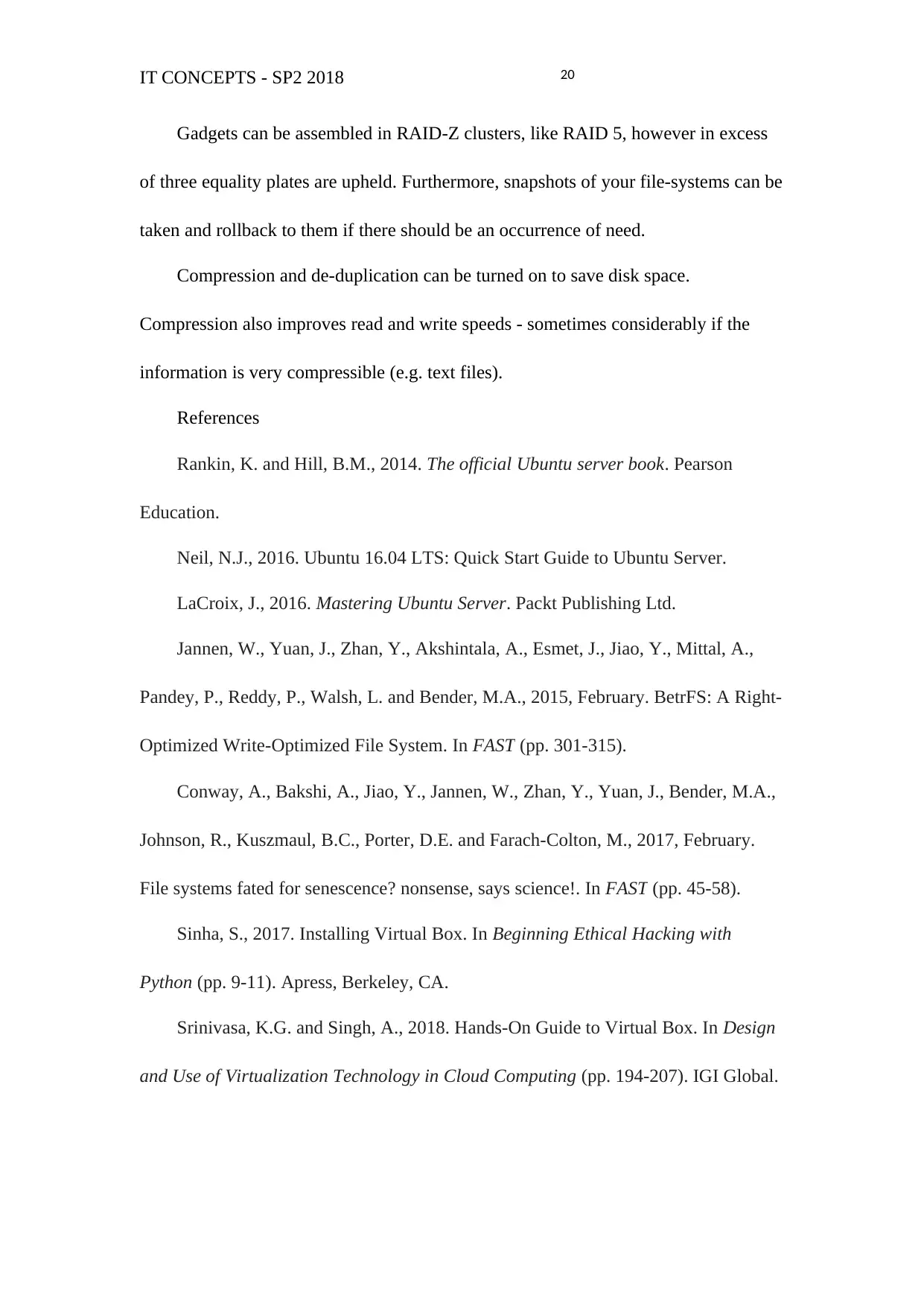
20IT CONCEPTS - SP2 2018
Gadgets can be assembled in RAID-Z clusters, like RAID 5, however in excess
of three equality plates are upheld. Furthermore, snapshots of your file-systems can be
taken and rollback to them if there should be an occurrence of need.
Compression and de-duplication can be turned on to save disk space.
Compression also improves read and write speeds - sometimes considerably if the
information is very compressible (e.g. text files).
References
Rankin, K. and Hill, B.M., 2014. The official Ubuntu server book. Pearson
Education.
Neil, N.J., 2016. Ubuntu 16.04 LTS: Quick Start Guide to Ubuntu Server.
LaCroix, J., 2016. Mastering Ubuntu Server. Packt Publishing Ltd.
Jannen, W., Yuan, J., Zhan, Y., Akshintala, A., Esmet, J., Jiao, Y., Mittal, A.,
Pandey, P., Reddy, P., Walsh, L. and Bender, M.A., 2015, February. BetrFS: A Right-
Optimized Write-Optimized File System. In FAST (pp. 301-315).
Conway, A., Bakshi, A., Jiao, Y., Jannen, W., Zhan, Y., Yuan, J., Bender, M.A.,
Johnson, R., Kuszmaul, B.C., Porter, D.E. and Farach-Colton, M., 2017, February.
File systems fated for senescence? nonsense, says science!. In FAST (pp. 45-58).
Sinha, S., 2017. Installing Virtual Box. In Beginning Ethical Hacking with
Python (pp. 9-11). Apress, Berkeley, CA.
Srinivasa, K.G. and Singh, A., 2018. Hands-On Guide to Virtual Box. In Design
and Use of Virtualization Technology in Cloud Computing (pp. 194-207). IGI Global.
Gadgets can be assembled in RAID-Z clusters, like RAID 5, however in excess
of three equality plates are upheld. Furthermore, snapshots of your file-systems can be
taken and rollback to them if there should be an occurrence of need.
Compression and de-duplication can be turned on to save disk space.
Compression also improves read and write speeds - sometimes considerably if the
information is very compressible (e.g. text files).
References
Rankin, K. and Hill, B.M., 2014. The official Ubuntu server book. Pearson
Education.
Neil, N.J., 2016. Ubuntu 16.04 LTS: Quick Start Guide to Ubuntu Server.
LaCroix, J., 2016. Mastering Ubuntu Server. Packt Publishing Ltd.
Jannen, W., Yuan, J., Zhan, Y., Akshintala, A., Esmet, J., Jiao, Y., Mittal, A.,
Pandey, P., Reddy, P., Walsh, L. and Bender, M.A., 2015, February. BetrFS: A Right-
Optimized Write-Optimized File System. In FAST (pp. 301-315).
Conway, A., Bakshi, A., Jiao, Y., Jannen, W., Zhan, Y., Yuan, J., Bender, M.A.,
Johnson, R., Kuszmaul, B.C., Porter, D.E. and Farach-Colton, M., 2017, February.
File systems fated for senescence? nonsense, says science!. In FAST (pp. 45-58).
Sinha, S., 2017. Installing Virtual Box. In Beginning Ethical Hacking with
Python (pp. 9-11). Apress, Berkeley, CA.
Srinivasa, K.G. and Singh, A., 2018. Hands-On Guide to Virtual Box. In Design
and Use of Virtualization Technology in Cloud Computing (pp. 194-207). IGI Global.

21IT CONCEPTS - SP2 2018
1 out of 21
Related Documents
Your All-in-One AI-Powered Toolkit for Academic Success.
+13062052269
info@desklib.com
Available 24*7 on WhatsApp / Email
![[object Object]](/_next/static/media/star-bottom.7253800d.svg)
Unlock your academic potential
© 2024 | Zucol Services PVT LTD | All rights reserved.




